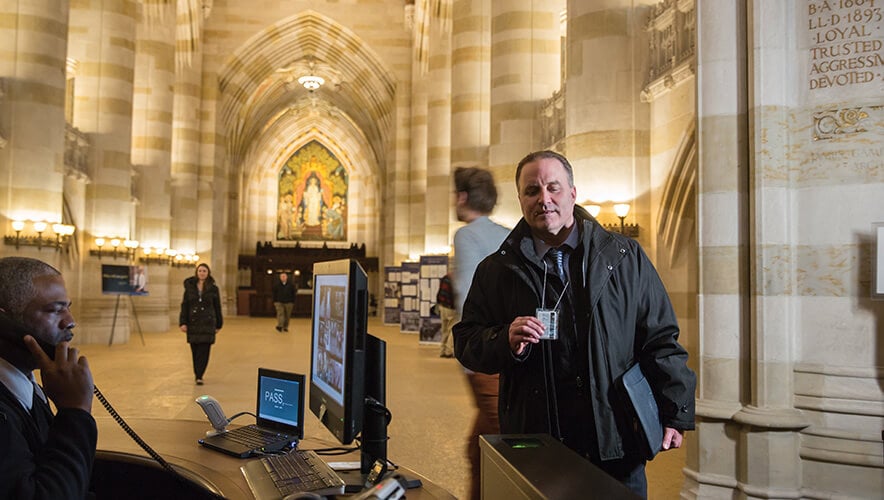Unusual Suspects: How Yale is Using Analytics to Monitor Campus Access
Lux et Veritas. Light and Truth. That is the motto of Yale University, which since its founding in 1701 has attracted students and faculty from all over the world to its campus—first in Saybrook and then in New Haven, Connecticut.
Roughly 16,000 students annually attend the university for undergraduate, master’s, and doctoral programs—many of them conducting research to shed light and share the truth of their findings with society.
But that work was cast into doubt when on 10 March, university officials announced that students should plan to remain at home and attend classes online at least through 5 April to limit the spread of the coronavirus. The university then extended that prohibition through the end of the academic year, allowing some exceptions for students who could not return home.
“It matters greatly to me that if you are in the very difficult position of not having a safe place to go to off campus, you know that we will take care of you,” said Yale College Dean Marvin Chun, as reported by The Yale Daily News.
Yale officials also needed to create accommodations for individuals who work at the hospital on its campus and are engaged in research on COVID-19, the disease caused by the SARS CoV-2 coronavirus. These accommodations—and being able to track who was working in research labs and accessing campus facilities—upped the ante for Yale’s public safety team.
“There is a lot of concern right now on campus because of the amount of research that’s happening with a lack of staff there,” says Steve Donnelly, manager of access control and ID centers for the university. “There is concern of items going missing or sensitive equipment being moved without anyone’s knowledge.”
To help manage access and provide insight into where people are on campus, without necessarily having a physical presence on site, Yale has turned to its longtime access control system provider AMAG and the company’s Symmetry Business Intelligence system.
The system, which is designed to be used with an AMAG access control solution, analyzes individuals’ access history and patterns. It then uses that information to assign individuals a risk score—which is continuously updated as the system is fed more data about that individual’s usage—and can prohibit an individual from gaining authorized access to a site. Symmetry also flags anomalous behavior that can help identify potential threats and mitigate their effects.
For instance, an employee is scheduled to work at building A until 5:00 p.m. If that employee began accessing another building at 2:00 a.m. that he was not scheduled to work in, Symmetry would flag that behavior as potentially risky. End users would then be able to see that flagged behavior on a dashboard—which provides a real-time visual representation of the movement and trends of people—and take steps to prevent the unusual behavior from occurring again.
Yale had been in discussions with AMAG for roughly a year about creating such an analytics platform to help the university have greater insight into activity at its 450 facilities on campus, which together have roughly 7,000 doors and an average of 800,000 reads per day across the system.
“It was really important to have that unusual data stick out to us,” Donnelly says. “We’re a pretty small team, considering our infrastructure. It’s difficult for us to find those weaknesses in our system because we have so many sensitive areas on campus that need to be tracked very carefully.”

Symmetry allows Yale to look at three risk scores: the location someone is attempting to access, the access control card holder, and the date and time of the access attempt. Using those three scores, Symmetry makes a calculation that provides an overall risk score—which can be used to limit an individual’s authorized access.
The system also allows end users to see why it made a particular risk score determination, which Donnelly says is important because it allows the team to make sure the system is working as intended.
Only Donnelly and two of his colleagues have access to the Symmetry system data. Yale would share that data with law enforcement only if it was needed to investigate a crime or with written approval from the university’s general counsel, says Dave Boyd, director of strategic planning and management for public safety.
Originally, Yale was interested in adopting the system to help manage access to sensitive facilities, like research labs where controlling and monitoring access is a major concern to prevent intellectual property theft and nuclear regulator monitoring facilities where security is paramount. Boyd adds that the university also hoped the system would help prevent electronic theft and assist campus police in solving electronic thefts on campus.
But with classes moved online for the remainder of the 2020 spring semester and a limited on-site presence, Yale is primarily using the system to monitor activity associated with students approved to continue living on campus and with its research facilities, Boyd says.
“All the research continues to go on, and we’re monitoring to see who is getting in and out of research facilities now,” he explains. “We’re talking with them daily because it’s been a big challenge for us…who is entering the facilities? And should they be?”
The university is also exploring ways Symmetry could be used to help keep students and staff safe once they return to a reopened campus.
One possibility is using the system to help with contact tracing should someone on campus be diagnosed with COVID-19. Symmetry could be used to create a list of students and staff that were in the same rooms with that positive individual, allowing campus safety to notify them of the need to self-isolate to stop the disease from spreading.
“We’re in talks right now that this might be a solution to help us come back,” Boyd adds.
